
Hiroshi Kashiwabara in March 2019. Photo © Brett Homenick.
Hiroshi Kashiwabara is a prolific film and television scriptwriter who penned three screenplays for the Godzilla series in the 1990s and early 2000s. Mr. Kashiwabara wrote the script for Godzilla vs. SpaceGodzilla (1994), and (with fellow screenwriter Wataru Mimura) crafted the scripts for Godzilla 2000 (1999) and Godzilla vs. Megaguirus (2000). Prior to his involvement in the Godzilla series, Mr. Kashiwabara wrote episodes of Toho’s child-oriented tokusatsu TV program Kure Kure Takora (1973-74) before contributing to the screenplay rewrite for Gunhed (1989). In March 2019, Mr. Kashiwabara discussed his career in monster movies with Brett Homenick. This interview was translated by Makiko Nomoto.
Brett Homenick: Tell us about your early life, growing up. Where did you grow up, and what hobbies did you have as a young boy?
Hiroshi Kashiwabara: I was born here (in Ningyocho, Tokyo). When I was a child, there were seven movie theaters in Ningyocho. So I could often watch movies when I was a child. I also played baseball. When I was a child, I watched many American TV shows in Japan. So I liked America very much.
BH: For example, what did you watch?
HK: I watched Rawhide, Bronco, Combat!, and The Gallant Men. I watched many American TV shows in Japan.
BH: Talk about your interest in Western movies and TV shows. How did that develop, and which are your favorite American movies and Westerns?
HK: My favorites are John Ford’s The Searchers and She Wore a Yellow Ribbon. I also like Howard Hawks’ Red River. Another favorite is The Alamo by director John Wayne.
BH: When did you get interested in writing as a TV writer or as a movie screenwriter? How did you become interested in writing?
HK: At first, I wanted to become a director. In order to become a director, I had to learn how to write scripts.
BH: What steps did you take in order to become a director or a screenwriter? What did you do?
HK: I went to a screenwriting school called Scenario Kenkyujo (Screenwriting Research Institute). It’s still in Akasaka. During my studies there, I debuted as a writer with scripts for Kure Kure Takora. I was a university sophomore.
BH: What do you remember about working on that program and writing the scripts?
HK: I have many memories. It was called an “educational program,” but it was not educational. It was indecent and violent. When the main character Takora wants something, he takes it by any means necessary, including violence. So it was violent and not educational for kids.
BH: So when you were given this job, were you given any direction? Could you write anything?
HK: It was a five-minute TV program, so in the program, when Takora wants something, he comes up with an idea in order to get it. It’s the same as Ocean’s 11. (laughs) But in five minutes! (laughs)
BH: So you had freedom to come up with stories.
HK: To some extent, I had freedom.
BH: In what ways were you not free?
HK: Toho had to make the things that Takora wanted, so as long as Toho could make it, it was fine.
BH: In your episodes, what were things Takora wanted?
HK: There were many things. One of them was a fire extinguisher. In other episodes, he wanted a radio and a toaster.
BH: How many did you write?
HK: I wrote about 30 episodes.
BH: Which one was your favorite?
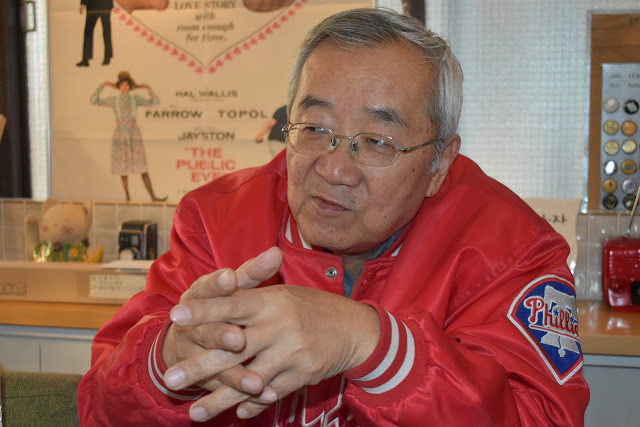
Photo © Brett Homenick.
HK: In this episode, Takora pretended to be crazy. So everybody gave him everything (he wanted) because they thought he was crazy. After he was given something, he returned to normal. So when they found out that he was really normal, they realized that he was just pretending to be crazy. So they got angry at him. As a result, Takora really became crazy. (laughs) Five minutes! (laughs)
BH: What was the most unusual thing you wrote for Takora?
HK: I think the crazy story is the strangest episode. (laughs)
BH: What’s another story you wrote?
HK: In the episode, Takora turned 60 years old, so he had bad teeth and couldn’t eat. (laughs) The title was “Sad Sixty.” (laughs)
BH: During this time, you wrote many scripts for other shows, like Seibu Keisatsu or Tantei Monogatari. Which work are you most proud of during this time?
HK: It’s Daitsuiseki (1978).
BH: Why are you most proud of it?
HK: It was an American-style police series with action and comedy. It was the first one ever made in Japan in that style.
BH: Let’s skip ahead and talk about Godzilla vs. SpaceGodzilla. How did you get hired to write the script for SpaceGodzilla?
HK: Toho offered it to me.
BH: Do you know why they chose you?
HK: Before that, I had connections with Toho. I wrote for Kure Kure Takora, and I helped rewrite the script of Gunhed, even though my name did not appear on it.
BH: You wrote Gunhed, the script?
HK: Yes. I was uncredited.
BH: Let’s talk about Gunhed first. How did you get hired on Gunhed?
HK: The director, Masato Harada, asked me to help him.
BH: Did you write the script originally, or did you change the script?
HK: At first, Mr. Harada wrote the script. After that, I changed it a little.
BH: What did you change?
HK: I changed the action scenes a little — maybe about 20% of the action scenes. My changes were like the movie Aliens. The script was not working very well, so I changed it to be more like Aliens.
BH: Is there anything else you could tell us about Gunhed?
HK: I don’t remember much because I only helped write the script. But I enjoyed it.
BH: What do you remember about Mr. Harada?
HK: Mr. Harada liked Howard Hawks, so he liked American movies. That’s why I enjoyed working with him. Mr. Harada wrote a scene inspired by Red River into the script.
BH: Which scene is that?
HK: It’s when the main female character (Brenda Bakke) was shot with an arrow and pulled it out.
BH: How long did you work on Gunhed?
HK: It took less than month.
BH: Do you have any other memories?
HK: Mr. Harada incorporated Red River and Aliens into the script. The main character’s name is Brooklyn because Mr. Harada likes American culture, just like I do. But I don’t remember anything else.
BH: What did you think about Gunhed as a film?
HK: I enjoyed working on it, but my name does not appear on the movie. The movie itself was so-so. It had both good points and bad points.
BH: Let’s go back to SpaceGodzilla. So you were hired to write the script. How much freedom did you have? Could you write an original story from scratch?
HK: The monsters that were used in the film had already been decided. So my job was to create a story using those monsters.
BH: There are two characters — Miki Saegusa and Gondo. These (characters) refer back to previous Godzilla movies. Did you choose to use Miki Saegusa, or was that Toho?
HK: Toho decided to use Miki Saegusa. But I chose to use Gondo because I liked his character.
BH: Tell us about the process of writing the script. For example, how many drafts were there? How long did it take?
HK: It took half a year to write. I rewrote it several times. I wrote the story first and then the script. The script had many changes.
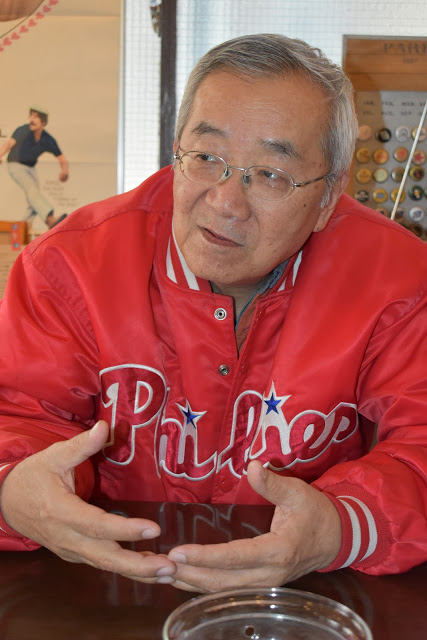
Photo © Brett Homenick.
BH: What was the original story like? What did you change? What were some of the original ideas?
HK: There was a budget problem. At that time, Daiei was producing a new Gamera movie. Fukuoka was used for monster scenes in both productions. The two productions discussed the locations to be used, and I had to write the script according to the negotiations.
BH: So did you originally want to use (Fukuoka) Dome?
HK: Actually, I did want to use Fukuoka Dome, but it was decided to change it to Fukuoka Tower because Daiei had already set part of its Gamera movie there.
BH: What other changes did you make to the story during this process?
HK: At first, one of the main characters was supposed to be played by Kenichi Hagiwara, but he wasn’t available. So Akira Emoto was cast instead. So I rewrote the character to be more suitable for Mr. Emoto.
BH: What was the character originally going to be like?
HK: Mr. Hagiwara was more like an outlaw, like Rambo. But Mr. Emoto was less violent than Mr. Hagiwara. (laughs)
BH: So he was supposed to be more like Rambo?
HK: Mr. Hagiwara would have been more violent, like Rambo.
BH: Any other changes to the story?
HK: That’s all.
BH: Originally, was the budget higher, and they cut the budget?
HK: (in English) Cut.
BH: What was it like to work with Mr. Tomiyama during this process?
HK: He was a good producer. He told me Toho’s requests. Mr. Tomiyama was easy to work with.
BH: How did you approach the story in a general way? What was the style and approach that you wanted for SpaceGodzilla?
HK: (in English) Not serious — entertainment.
BH: There’s also a love-story theme to this movie. Was that your idea, or was that Mr. Tomiyama’s idea?
HK: My idea.
BH: Why a love story?
HK: I like Miki Saegusa. (laughs) There hadn’t been a love story with her at the time, so I suggested making a love story with her.
BH: Jun Hashizume — how do you think he was as a love interest for Miki Saegusa? Was he a good actor for that, or not a good match?
HK: To be honest, it was not a good match. (laughs)
BH: Did you have another actor in mind who would have been better? Who would have been an actor that you would have liked?
HK: Mr. Hashizume was very serious, so I would have preferred a less serious person.
BH: Next, let’s talk about working with director Kensho Yamashita. What was it like to work with Mr. Yamashita on this movie as director?
HK: It was easy. He didn’t make many requests.
BH: Did you think that he could handle the material? Was he a good director for Godzilla, or was he not a good match for Godzilla?
HK: (in English) Not.
BH: Why not?
HK: He didn’t like monster movies. He liked human dramas.
BH: Do you know why he got hired to direct SpaceGodzilla?
HK: Mr. Yamashita belonged to Toho, and Toho selected him.
BH: Did you visit the set during filming? Did you go to any locations?
HK: I went to the island.
BH: Where was Birth Island filmed?
HK: It was a little island near Amami Oshima, which is near Okinawa.
BH: Do you have any interesting memories from going on location?
HK: I thought it was difficult to shoot because there was no actual Godzilla on set. (laughs) A lot of staff members went to the island on which there were few people. So I thought it was interesting to see so many crew members go to an isolated island to make a movie.
The shooting in Fukuoka was more interesting. In Fukuoka, many people were running away from SpaceGodzilla, so it was interesting to see.
BH: Were you in the scene, running away?
HK: No. (laughs)
BH: Were there any changes to the script during filming?
HK: On SpaceGodzilla, there were no changes. But on Godzilla 2000, there were many changes.
BH: Let’s go back to Miki Saegusa. Of course, her character is changing; she’s falling in love. So how did you approach Miki’s character for this movie?
HK: I wrote a love story for her, but I didn’t change her character. I just wrote a love story.
BH: Talk about writing the Mafia characters.
HK: It was a side story. The main story is Godzilla vs. SpaceGodzilla. I didn’t develop the Mafia characters very much because it was just a side story.
BH: They speak English in the movie. Did you write in Japanese?
HK: Japanese, of course! (laughs) I can’t speak English. (laughs)
BH: How much of the monster scenes would you write? Would it just say, “Monsters fight,” in the script?
HK: I wrote the scenes for Godzilla vs. humans. But the monster vs. monster scenes were handled by Mr. Kawakita.
BH: For the humans vs. monster scenes, did you have any specific ideas or inspiration that you can talk about?
HK: One was the Howard Hawks movie Hatari! In that movie, John Wayne catches many animals. It’s the same thing here. It was about how we could catch Godzilla, just like it was with John Wayne and the animals. (laughs)
BH: Which scene in SpaceGodzilla is that, the Hatari! scene?
HK: At first, I came up with the idea that they catch Godzilla with a (rocket-)net as in Hatari! in which a lot of monkeys are caught with one. But it didn’t work.
BH: So Hatari! (also inspired) the “Yuki Special”?
HK: Yes.
BH: So John Wayne and Yuki are…
HK: The same! (laughs)
BH: What was Toho’s reaction to your script? Were they happy with it, or did they offer many changes?
HK: Toho said the script for SpaceGodzilla was good. Godzilla 2000… (laughs) Megaguirus was good.
BH: What did you think of SpaceGodzilla as a movie?
HK: So-so.
BH: Let’s move on to Godzilla 2000. First, let’s talk about Godzilla ‘98. What did you think of Godzilla ‘98?
HK: It’s not Godzilla.
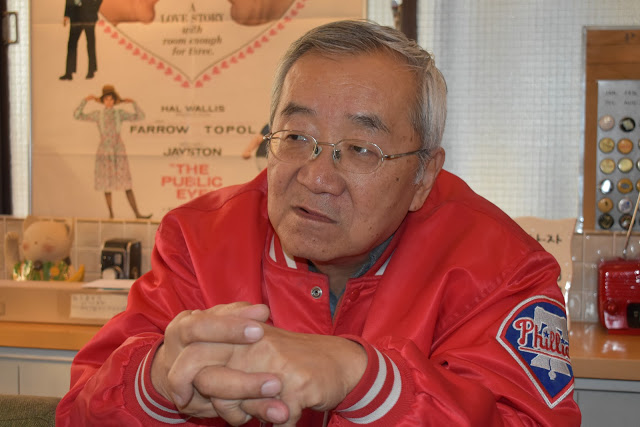
Photo © Brett Homenick.
BH: Now let’s talk about Godzilla 2000. You worked with Mr. (Wataru) Mimura. How did you and Mr. Mimura get hired to write Godzilla 2000?
HK: Mr. Mimura was a Toho screenwriter, so Toho wanted use Mr. Mimura with me.
BH: Did they explain why (they wanted) two screenwriters together?
HK: Producer Tomiyama used Mr. Mimura in order to represent his (Mr. Tomiyama’s) opinions and ideas because Mr. Mimura was a Toho screenwriter. It was the same situation on Godzilla: Final Wars.
BH: Why were you hired as well for Godzilla 2000?
HK: I wrote the screenplay for SpaceGodzilla. I was in a higher position as a screenwriter than Mr. Mimura.
BH: Were you the main writer?
HK: Yes, the main writer.
BH: How much freedom did you have to write the story?
HK: At first, I wrote the story freely. After that, Toho checked the story. There were many opinions. I incorporated these opinions and rewrote it, so the final draft was totally changed.
BH: Was Mr. Mimura making those changes, or did you go back and rewrite?
HK: There were (three) versions of the story written — my version, Mr. Mimura’s version, and Mr. Tomiyama’s. The main version was my story. There were many opinions, so so Mr. Mimura and I changed the story.
BH: What can you tell us about your original story?
HK: It was an alien invasion story.
BH: So everyone wrote his own scenario?
HK: Just stories. My story was selected.
BH: Who ultimately chose your (story)?
HK: There was a strategy. They wanted to select my story. However, they wanted to make it look like there was competition between the three of us. But it was not really a competition; the outcome was predetermined. It was like a fixed race.
BH: This was right after the American Godzilla movie in ‘98. So was there any idea to respond to that movie?
HK: In the American movie, Godzilla is not a monster. It’s just a living creature, like the T-rex in Jurassic Park. So we wanted to make Godzilla more like a monster that doesn’t exist in this world.
BH: Well, there is a scene in the opening of Godzilla 2000 with the jeep. I always thought this was like Jurassic Park.
HK: (laughs)
BH: Was that Jurassic Park?
HK: No. Originally, a man was supposed to be urinating outdoors, and while he was doing that, Godzilla would suddenly appear. However, Toho rejected that idea. But I like the first scene in Hokkaido in which Godzilla appears. The resemblance (to Jurassic Park) was just a coincidence. I like jeeps.
BH: Did you have any influences, whether it was from Hollywood movies or even your interests? What influences did you put into this movie?
HK: Twister was an influence. There was nothing else. There was a spaceship underwater, so the director wanted the spaceship to be lifted out of the water, like in Raise the Titanic. But I opposed this idea. Balloons would have been used to raise the spaceship, but I thought that it wasn’t good to use balloons.
BH: Let’s talk about some of the characters, like Miyasaka or Katagiri. Talk about creating these characters and your ideas for them.
HK: Shiro Sano (who played Miyasaka) was a serious person. I don’t like either characters very much. I don’t think they worked very well. I think Shin Godzilla handled those kinds of characters better.
BH: What was the problem with these two characters? Why didn’t they work?
HK: The production didn’t spend much money on the drama scenes. On the other hand, Shin Godzilla spent much more money on the drama scenes.
BH: For the GPN team, there’s a little girl. Why did you choose to write a little girl as one of the main characters?
HK: She was Mr. Mimura’s idea.
BH: What were Mr. Mimura’s other ideas?
HK: He named new machines and new weapons. (laughs)
BH: How many drafts of the script were there?
HK: At least six or seven.
BH: Is it (because) Toho had many comments?
HK: Toho and the director.
BH: What were the comments that Toho and Mr. Okawara had?
HK: The director wanted to use his own ideas, so he gave many opinions about the script. I didn’t like the director’s ideas. Mr. Mimura rewrote the final draft of the script. I tried to quit the production.
BH: Why couldn’t you quit?
HK: I had no choice but to continue.
BH: The main monster is Orgah. Did you have any role in creating this monster, or was that all Toho?
HK: The monster’s design was done by the design team. The monster turned out to be a different shape from what I wrote at first.
BH: What did you imagine?
HK: Its face was too big. What I imagined was different from its actual face. But that’s very common.
BH: Generally, what was it like to work with Mr. Okawara?
HK: Mr. Okawara specialized in human dramas, not monster movies. I don’t think Mr. Okawara understood entertainment. He didn’t know how to make action scenes work or look real in entertainment movies. For example, in the last scene, if someone slid down an elevator shaft without gloves or a towel, his hands would get burned.
BH: What did you think of the finished film?
HK: (in English) Not good — bad.
BH: What was Toho’s reaction to the movie? Was Toho happy or not happy?
HK: (in English) Not happy.
BH: What was Toho’s response to that?
HK: After that, Mr. Okawara didn’t direct another movie at Toho.
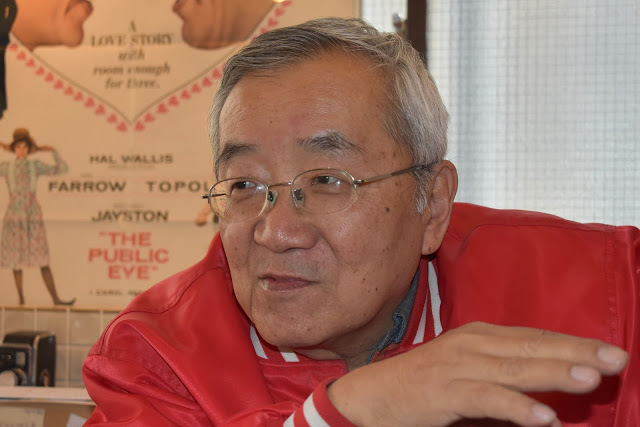
Photo © Brett Homenick.
BH: Let’s talk about Megaguirus. Once again, you and Mr. Mimura were teamed up. So how did you get approached to write Megaguirus?
HK: It was the revenge of Godzilla 2000. (laughs)
BH: How did you and Mr. Mimura get hired to write it?
HK: Because it was the revenge of Godzilla 2000, using the same staff was good.
BH: In this movie, there’s a female heroine. That’s very different. Where did that idea come from?
HK: It was Toho’s idea.
BH: What did you think of the idea?
HK: It was good.
BH: What kind of new or original ideas did you want to bring to this movie? Did you have freedom?
HK: I had complete freedom in what to write.
BH: So what were your influences or inspirations?
HK: (In English) I like Rodan — Megaguirus. The “ya” in Shibuya means valley — a low place. So I thought it would be interesting to flood Shibuya. The black hole was Mr. Tomiyama’s idea.
BH: What about the Dimension Tide?
HK: The name is Mr. Mimura’s! (laughs)
BH: What else did Mr. Mimura bring to Megaguirus?
HK: Mr. Mimura came up with the idea of the last scene in which Godzilla is sent into space through a wormhole.
BH: What was it like to work with Mr. (Masaaki) Tezuka? How was he as a director to work with?
HK: It was the first time for Mr. Tezuka to direct. It was easy to work with him. Mr. Tezuka came up with the idea of the post-credits school scene epilogue.
BH: Did you write it?
HK: It was his idea, but I wrote it.
BH: How many drafts of the script (were there)?
HK: There were about four drafts.
BH: Was this a smoother process than before?
HK: Yes, very smooth.
BH: How long, overall, was the process of writing?
HK: About four or five months.
BH: Normally, when would the process start? Would it start in December or January?
HK: Usually, the movie would be released in December. So usually we started in January or December of the previous year. As for Megaguirus, it was a little slower. We started in February. I don’t remember very well, but the time it took to write this movie was shorter than the previous two Godzilla movies.
BH: Do you have any other memories that you’d like to share about Megaguirus?
HK: I like it very much. I especially like the Shibuya flood scene. I also like the heroine, as well as the scene in which she’s riding on Godzilla’s back.
BH: Why didn’t you come back for Godzilla against Mechagodzilla?
HK: It was Mr. Tomiyama’s decision. My salary was high! (laughs)
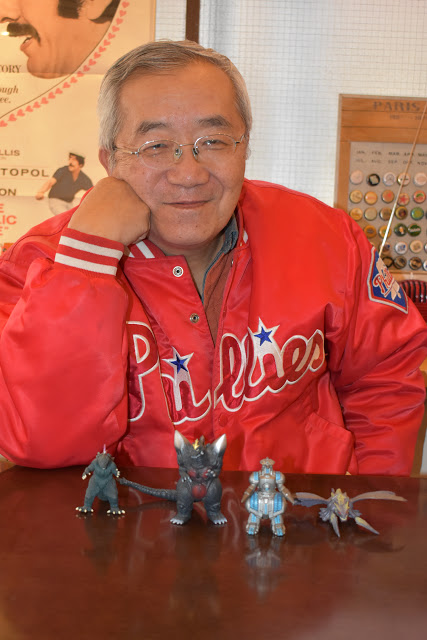
Photo © Brett Homenick.
BH: Of the three Godzilla movies — SpaceGodzilla, 2000, and Megaguirus — which is your favorite?
HK: Megaguirus. Next is SpaceGodzilla.
BH: Of all the Godzilla movies, which is your favorite?
HK: It’s difficult! Of course, it’s the first Godzilla. Number two is King Kong vs. Godzilla.
BH: Did you see it as a boy?
HK: Yes. I saw it in real time.
BH: So that was your first Godzilla movie?
HK: Yes.
BH: When you were a boy, what other movies did you see in the theater?
HK: I like Varan and Rodan. I saw them all in real time. I saw them in a theater in Hibiya. I also like space movies. I saw Battle in Outer Space and The Mysterians. The Mysterians is number one. I also saw Gorath.
BH: What contribution to the Godzilla series are you most proud of? For example, what do you think was your best idea?
HK: Mr. Emoto’s character (in SpaceGodzilla). I like him.
BH: Did you like Shin Godzilla?
HK: I liked it, but I don’t think it was a Godzilla movie. For example, the role of Godzilla could have replaced with aliens from space and been the same.
BH: Do you have any final comments you’d like to say before we finish?
HK: Before Shin Godzilla, only Toho controlled the Godzilla movies. Godzilla movies usually made about a billion yen, but Shin Godzilla made about 8.5 billion yen. That’s because general audiences went to see the movie, too, not just Godzilla fans. So it was a big hit. I’m looking forward to seeing the next Godzilla movie.
American companies can spend a lot more money on Godzilla movies than Toho. So I look forward to seeing what Toho will make next.